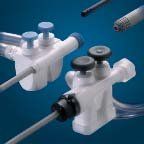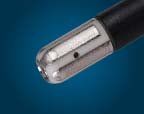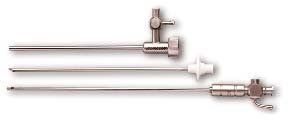Microlaparoscopy
Laparoscopy has revolutionized the practice of modern operative gynecology and has progressed from simple diagnostic work to advanced operative procedures.[

Discussion / General Considerations
Despite marked advances in non-invasive diagnostic imaging, accurate diagnosis of pelvic disease frequently depends on direct visualization. Microlaparoscopy provides a definitive diagnosis with low morbidity and cost and is appropriate for diagnostic procedures such as evaluation of chronic pelvic pain[2] and other indications as summarized in Table 1. It is also useful in diagnosing endometriosis, ruptured cysts, and inguinal hernia. Second-look microlaparoscopy can be done after ovarian cancer treatment or adhesiolysis to assess recurrence. In addition, it allows accurate diagnosis of peritoneal factor causes of infertility, including tubal adhesions,[3] and results of chromopertubation.[4] The feasibility of sterilization reversal versus referral for in vitro fertilization can also be determined.[5]
Therapeutic options can be limited in microlaparoscopy, especially if the procedure is performed under local anesthesia in an office setting. Although the optical quality of the microlaparoscope is good, the field of view is smaller than larger diameter scopes. Newly developed 2-3 mm suction irrigators are resolving the problem of performing peritoneal lavage (Figure 2) without a larger port. Most bleeders can be controlled with small diameter coagulating devices (Figure 3). Small diameter instruments such as graspers and scissors are currently available, with improved versions in development, but are delicate and need to be handled with care. Also, it can be difficult to remove bulky tissue through small trocars.
Evaluation of:
Pain Mapping
Differential Diagnosis:
Treatment Monitoring:
Infertility Evaluation


Figure 3. 2.7 mm BICAP® Probe
However, microlaparoscopy is highly efficacious in many cases, and careful patient selection is key to the success of the procedure. It is not an entirely painless procedure, but discomfort is usually well tolerated. Patients with psychiatric illnesses, especially anxiety disorders, may be unable to tolerate the stress of being alert during the operation. Any contraindication for laparoscopy is a contraindication for microlaparoscopy.
Procedure
The general principle of the procedure deviates little from standard laparoscopy and can be performed in various settings, but is commonly done in a hospital minor procedure room. When done in the office treatment room, adequate monitoring, resuscitation equipment, and rapid access to a tertiary care center must always be available.
After the equipment and supplies are on hand (Table 2), the patient empties her bladder and is placed in the dorsal lithotomy position. A blood pressure cuff and pulse oximeter are applied, and a Hep-Lock needle (18-22 gauge) is inserted. If necessary, a paracervical block is administered and a uterine manipulator inserted. Bupivacaine or lidocaine (5-10 ml) is injected with a 25-27 gauge needle through all layers of the abdomen at the Veress needle insertion site.

Figure 4. Reusable Small Diameter Trocar and Veress Needle
Patient comfort is an important factor - especially regarding the introduction of trocars. A disposable cannula with the Veress needle trocar can be used. The reusable small diameter cannula with disposable or reposable Veress needle trocar consistently remains sharp and is a reasonably priced alternative (Figure 4). The Veress needle trocar and cannula are introduced while the abdominal wall is manually elevated, and the uterus held down by the intrauterine manipulator. The Veress needle trocar is removed, leaving the cannula in place, and the microlaparoscope inserted. The extension tube is connected to the CO2 insufflator, and about 500-600 ml is passed into the peritoneal cavity. The insufflation rate should allow adequate visualization of the organs to be examined. Intra-abdominal pressure is kept at 8-10 mm Hg, with a maximum of 15 mm Hg. Only small volumes (500-2000 ml) of gas are infused so patient discomfort and vagal stimulation are minimized. Ancillary tools for manipulation, aspiration, culturing, or biopsies are inserted through secondary 2-3 mm trocars. A laser fiber can be passed through an ancillary 3 mm port permitting vaporization of small endometrial implants and incision of minimal adhesions.[6] At procedure's end, the gas is removed and the incision is closed with adhesive strips. The patient is then monitored, and is usually discharged within 2-4 hours.
Summary
Before introducing microlaparoscopy into the office setting, the physician must first obtain adequate training, become familiar with new equipment, learn proper patient selection, and have a staff trained in administering and monitoring analgosedation. It is advisable to perform the first few microlaparoscopy cases under general anesthesia, which allows the surgeon to become familiar with the scope and its placement, and to become comfortable with the microlaparoscopic video image of the surgical field.
Microlaparoscopy has the potential to significantly impact diagnostic evaluation, and its role in the ambulatory setting is now being explored. Advantages to the patient include less overall pain, shorter procedure time, fewer anesthesia risks, increased participation during surgery, and faster recovery. The surgeon benefits from decreased scheduling and preoperative delays, hospital paperwork and travel time. Local anesthesia is safer, allows the surgeon to communicate with the patient during the procedure, and offers a shorter and less morbid post-operative recovery.
References:
References
1. Nezhat C, Nezhat F, Luciano A, Siegler A, Metzger D, Nezhat CH, editors: Operative Gynecologic Laparoscopy: Principles and Techniques. New York: McGraw-Hill, 1995.
2. Palter SF, Olive DL: "Office microlaparos-copy under local anesthesia for chronic pelvic pain." J Am Assoc Gyne Laparos, 1996, 3:359-364.
3. Faber BM, Coddington CC III: "Micro-laparoscopy: a comparative study of diagnostic accuracy." Fertil Steril 1997, 67:952-954.
4. Haeusler G, Lehner R, Hanzal E, Kainz C: "Diagnostic accuracy of 2 mm microlaparoscopy." Acta Obstet Gyne Scand 1996, 75:672-675.
5. Feste JR: "Use of optical catheters for diagnostic office laparoscopy." J Reprod Med 1996, 41:307-312.
6. Dorsey JH, Tabb CR: "Mini-laparoscopy and fiber-optic lasers." Obstet Gyne Clin N Am 1991, 18:613-617.
Dr. Nezhat is clinical assistant professor of OB/GYN, and co-director, Stanford Endoscopy Center for Training and Technology, Stanford University School of Medicine, Stanford, CA. He is also clinical associate professor of OB/GYN, Mercer University School of Medicine in Macon, GA, and Director, Center for Special Pelvic Surgery, in Atlanta, GA.
